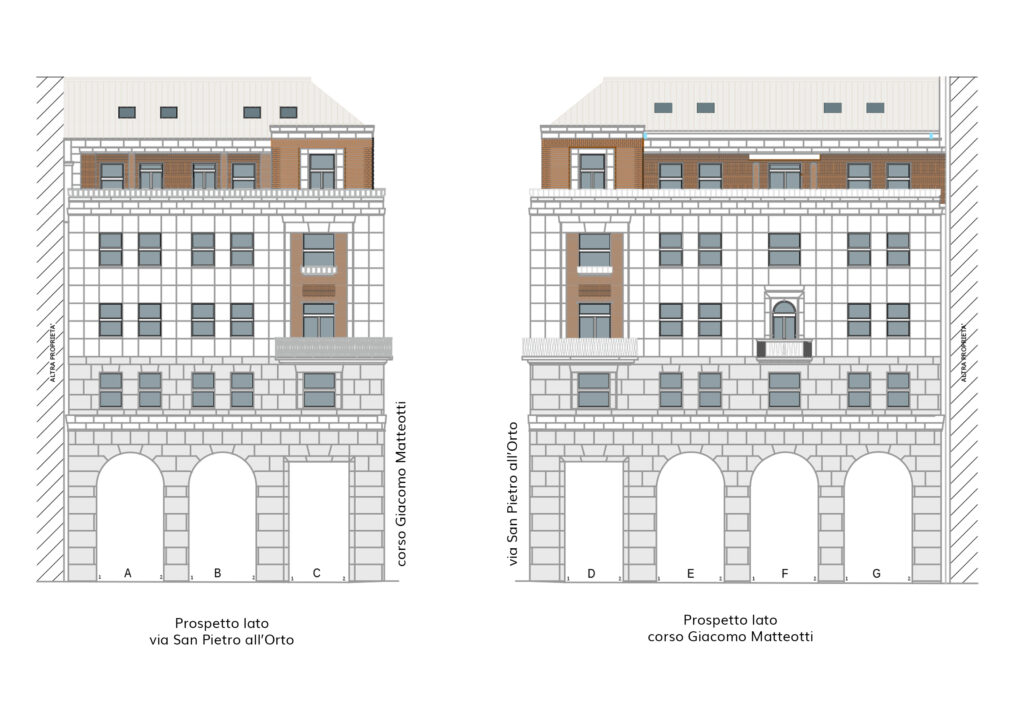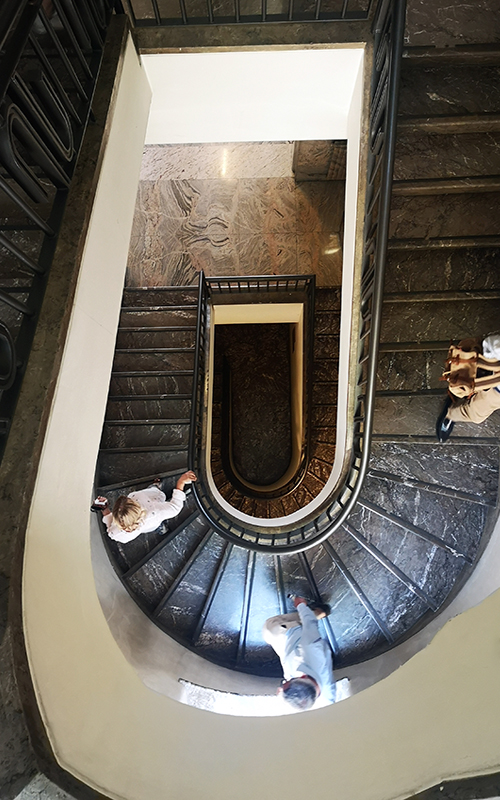Building renovation and facade redevelopment
Corso Matteotti
Type
Location
Corso Matteotti, Milan
Year
in progress
Surface area
1800 m2
Client
Kryalos
Head Designer
Arch. Marco Vigo, Arch. Alessia Garibaldi
Construction Management
Ing. Giorgio Piliego
Professional services
Concept, architectural and executive design, construction management
Corso Matteotti
The building in question is located in Milan in Corso Matteotti 5 and consists of 7 levels above ground and one basement. Built between 1933-1936 by the firm of engineer Luigi Fadini for the Società Anonima Iniziativa Edilizia and designed by the architect Emilio Lancia and the engineer Pugassi, the building is part of a complex for homes, offices and shops within a lot that runs from Via S. Pietro all’Orto to Corso Matteotti and ends in Via Monte Napoleone. The building became part of the new broad urban scene that was being consolidated in those years with the creation of what was then called Corso del Littorio and which would later take the name of Corso Matteotti. The facades are clean, free of ornamental superimpositions, and are expressed with a language that does not come close to rationalist themes, but neither does it recall the monumental themes beloved by the regime, even though the succession of arches and portholes on the ground floor could bring to mind certain surface textures of Muzio’s facades (Gramigna, Mazza, 2001).
It is one of the first works designed by Lancia after his collaboration with Gio Ponti. Though little known, Lancia was an undisputed protagonist of the Architectural culture of 20th-century Milan.


Restoration of the street front elevation
The main facade on Corso Matteotti and Via San Pietro all’Orto will undergo conservative restoration that envisages the removal of the surface patina deposited over time, the careful integration of damaged elements and the application of a protective layer, while fully respecting the original. The street front will also be upgraded with a lighting design that has been created to achieve a diffused light effect across the whole front, leaving out the portion of the portico that already has public street lighting. Lighting fixtures are primarily distributed on the string courses (20cm projection) that frame the portion between the end of the portico and the 4th floor, where there is a change in the stone cladding material. This solution involves the use of Outgraze fixtures by Flos specifically modulated along the length of the elevation and with long arms for total projection. The 5th floor, recessed with respect to the main elevation and with a terrace along the entire perimeter facing the street, has spot lighting that crown the building, highlighting the material variation created by the clinker bricks. Spot lighting is also placed on the corner balcony between Corso Matteotti and Via San Pietro all’Orto, again Outgraze lights by Flos.

Work on the ground floor
No trace of original elements of Lancia’s design remains on the ground floor except for the entrance gate. The design requires the demolition of the wall separating the porter’s lodge from the entrance to the building to create a larger space. This will be separated from the rear portion, which has a pre-existing bathroom, by a new plasterboard partition painted with a colour that picks up the pigment found in the stratigraphy of the walls of the stairs; this new partition will have a flush concealed door.
The new glass access door to the entrance will be set back to 120 cm from the last riser, in accordance with regulations; a new stair lift will be installed in the back portion of the access to allow easement access from via Montenapoleone 1.
All the stone paving will be preserved while the vertical granite cladding will be removed. The wall portions of the entrance hall will be covered with Calacatta-type Marbleplay ceramic slabs, while the new lift, complying with the regulations on eliminating architectural barriers, will be framed in an electro-painted metal casing. A new suspended ceiling with side light grooves will run from the entrance to the stairwell.
Work on the stairwell
The design envisages covering the semicircular walls of the stairwell with wallpaper.
The handrail base finished in dark grey marmorine will be repaired where required. Adaptation to the regulations requires work to raise the handrail by 10cm to reach a total height of 110cm from the tread. This addition will be clearly distinguishable from the original design of the parapet so that its proportion and stylistic composition will not be affected. The raised element will be metal and made integral with the existing parapet through mechanical coupling to avoid any welding on the pre-existing handrail. It will therefore be completely reversible.
A new chandelier, Arrangements by Michael Anastassiades will descend from the ceiling of the stairwell and will provide effective inter-floor lighting in addition to the existing spotlights installed on the stairwell window frames.


Work on the typical floor
The project involves the removal of the interior partitions that are not original to the Lancia design. The perimeter walls of the stairwell and adjacent portions on the west side are preserved. The stone and wood floors with their underlying subfloor will be removed. A new access door to the floor will be installed. The toilets will be demolished and replaced by new toilets located to the east and in the middle of the plan (in accordance with the regulations on eliminating architectural barriers) with plasterboard partitions. The design envisages the installation of a dry floating floor that can be completely reversed. A new plasterboard and concealed micro-perforated metal sheet ceiling will run along the central corridor of the floor plan, concealing the electrical and mechanical systems.
On the lift landing the wall facing the elevator door will be covered with a green Aver Marbleplay ceramic slab. The smoothed Venetian flooring is preserved and the existing light beige marmorine is re-proposed.




